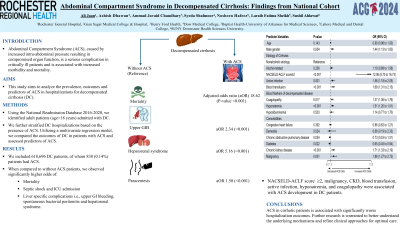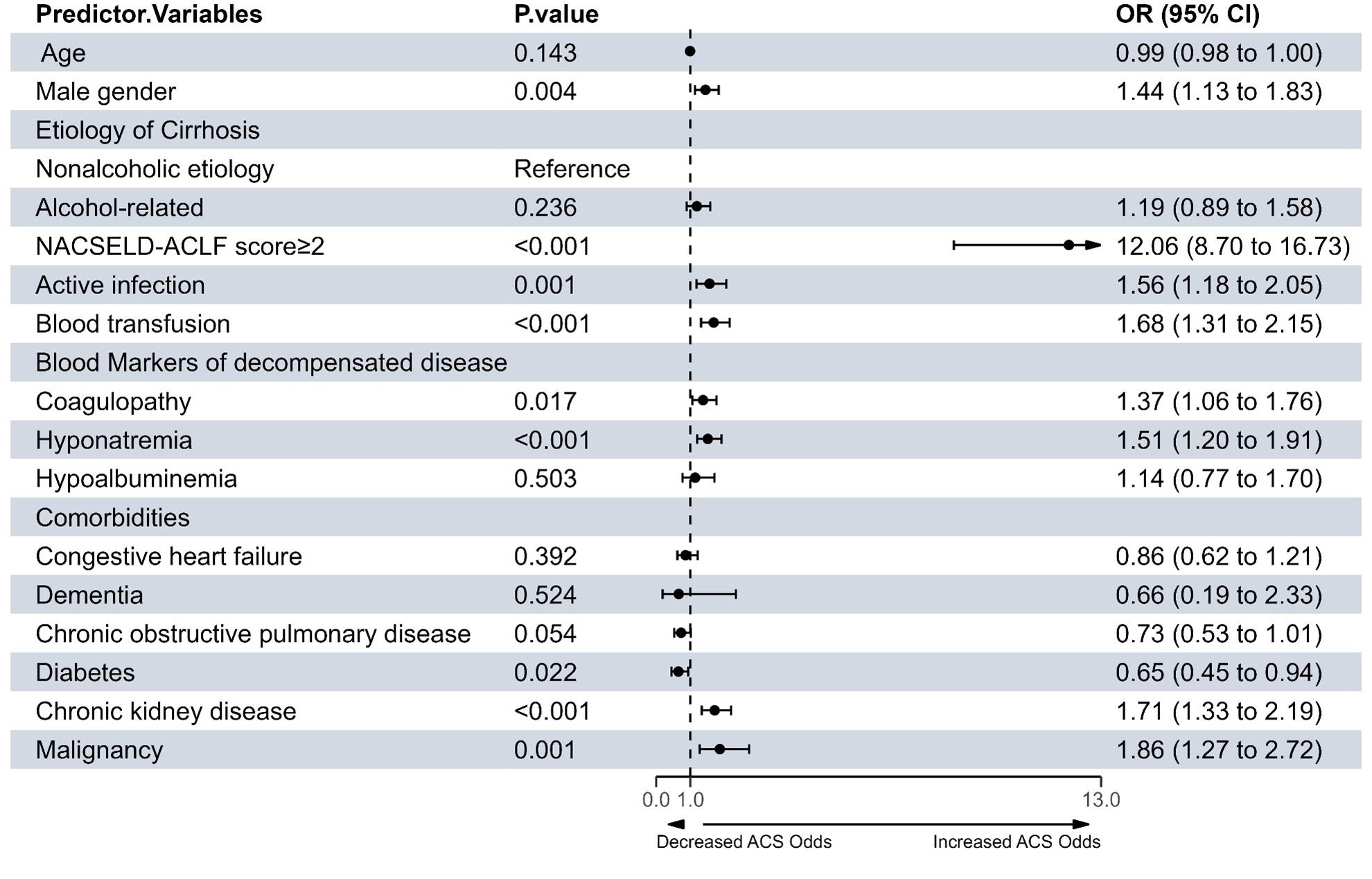Sunday Poster Session
Category: Liver
P1193 - Abdominal Compartment Syndrome in Decompensated Cirrhosis: Findings from a National Cohort
Sunday, October 27, 2024
3:30 PM - 7:00 PM ET
Location: Exhibit Hall E

Has Audio

Ali Jaan, MD
Rochester General Hospital
Rochester, NY
Presenting Author(s)
Ali Jaan, MD1, Ashish Dhawan, MBBS2, Ammad Javaid. Chaudhary, MD3, Syeda Shahnoor, MBBS4, Nosheen Hafeez, MD5, Laraib Fatima. Sheikh, 6, Sushil Ahlawat, MD, MS, MBBS7
1Rochester General Hospital, Rochester, NY; 2Gian Sagar Medical College and Hospital, Chandigarh, Chandigarh, India; 3Henry Ford Health, Detroit, MI; 4Dow Medical College, Karachi, Sindh, Pakistan; 5Baptist Health-University of Arkansas for Medical Sciences, North Little Rock, AR; 6Lahore Medical and Dental College, Rochester, NY; 7SUNY Downstate Health Sciences University, Brooklyn, NY
Introduction: Abdominal Compartment Syndrome (ACS), caused by increased intra-abdominal pressure resulting in compromised organ function, is a serious complication in critically ill patients and is associated with increased morbidity and mortality. This study aims to analyze the prevalence, outcomes and predictors of ACS in hospitalizations for decompensated cirrhosis.
Methods: Using the National Readmission Database 2016-2020, we employed the International Classification of Diseases, 10th revision, Clinical Modifications (ICD-10-CM) codes to identify adult patients (age >18 years) admitted with decompensated cirrhosis (DC). We further stratified DC hospitalizations based on the presence of ACS. Utilizing a multivariate regression model, we compared the outcomes of DC in patients with ACS and determined predictors of ACS. STATA 14.2 was utilized for statistical analysis.
Results: We included 618,696 DC patients, of whom 838 (0.14%) patients had ACS. After adjusting for confounding variables, we found significantly higher odds of mortality (adjusted odds ratio [aOR]:18.62, P< 0.001), septic shock (aOR: 9.28, P< 0.001), vasopressor requirement (aOR:10.03, P< 0.001), mechanical ventilation (aOR:14.20, P< 0.001) in cirrhotic patients with ACS (Table 1). Additionally, liver-specific complications such as upper gastrointestinal bleeding (aOR: 2.34, P< 0.001), hepatorenal syndrome (aOR: 5.16, P< 0.001), and spontaneous bacterial peritonitis (aOR: 2.58, P< 0.001) had elevated odds in the ACS group. Further, using multivariate logistic regression analysis, we determined predictors of ACS in DC patients. North American Consortium for the Study of End-Stage Liver Disease (NACSELD)-ACLF score ≥2 (aOR: 12.06), malignancy (aOR: 1.86), chronic kidney disease (aOR: 1.71), blood transfusion (aOR: 1.68), active infection (aOR: 1.56), hyponatremia (aOR: 1.51), and coagulopathy (aOR: 1.37) were predictive of ACS development in DC patients (Figure 1).
Discussion: ACS in cirrhotic patients is associated with significantly worse hospitalization outcomes as well as higher rates of liver-specific complications. Early identification and prompt management of this vulnerable patient cohort are imperative to enhance clinical outcomes. Further research is warranted to better understand the underlying mechanisms and refine clinical approaches for optimal care.

Note: The table for this abstract can be viewed in the ePoster Gallery section of the ACG 2024 ePoster Site or in The American Journal of Gastroenterology's abstract supplement issue, both of which will be available starting October 27, 2024.
Disclosures:
Ali Jaan, MD1, Ashish Dhawan, MBBS2, Ammad Javaid. Chaudhary, MD3, Syeda Shahnoor, MBBS4, Nosheen Hafeez, MD5, Laraib Fatima. Sheikh, 6, Sushil Ahlawat, MD, MS, MBBS7. P1193 - Abdominal Compartment Syndrome in Decompensated Cirrhosis: Findings from a National Cohort, ACG 2024 Annual Scientific Meeting Abstracts. Philadelphia, PA: American College of Gastroenterology.
1Rochester General Hospital, Rochester, NY; 2Gian Sagar Medical College and Hospital, Chandigarh, Chandigarh, India; 3Henry Ford Health, Detroit, MI; 4Dow Medical College, Karachi, Sindh, Pakistan; 5Baptist Health-University of Arkansas for Medical Sciences, North Little Rock, AR; 6Lahore Medical and Dental College, Rochester, NY; 7SUNY Downstate Health Sciences University, Brooklyn, NY
Introduction: Abdominal Compartment Syndrome (ACS), caused by increased intra-abdominal pressure resulting in compromised organ function, is a serious complication in critically ill patients and is associated with increased morbidity and mortality. This study aims to analyze the prevalence, outcomes and predictors of ACS in hospitalizations for decompensated cirrhosis.
Methods: Using the National Readmission Database 2016-2020, we employed the International Classification of Diseases, 10th revision, Clinical Modifications (ICD-10-CM) codes to identify adult patients (age >18 years) admitted with decompensated cirrhosis (DC). We further stratified DC hospitalizations based on the presence of ACS. Utilizing a multivariate regression model, we compared the outcomes of DC in patients with ACS and determined predictors of ACS. STATA 14.2 was utilized for statistical analysis.
Results: We included 618,696 DC patients, of whom 838 (0.14%) patients had ACS. After adjusting for confounding variables, we found significantly higher odds of mortality (adjusted odds ratio [aOR]:18.62, P< 0.001), septic shock (aOR: 9.28, P< 0.001), vasopressor requirement (aOR:10.03, P< 0.001), mechanical ventilation (aOR:14.20, P< 0.001) in cirrhotic patients with ACS (Table 1). Additionally, liver-specific complications such as upper gastrointestinal bleeding (aOR: 2.34, P< 0.001), hepatorenal syndrome (aOR: 5.16, P< 0.001), and spontaneous bacterial peritonitis (aOR: 2.58, P< 0.001) had elevated odds in the ACS group. Further, using multivariate logistic regression analysis, we determined predictors of ACS in DC patients. North American Consortium for the Study of End-Stage Liver Disease (NACSELD)-ACLF score ≥2 (aOR: 12.06), malignancy (aOR: 1.86), chronic kidney disease (aOR: 1.71), blood transfusion (aOR: 1.68), active infection (aOR: 1.56), hyponatremia (aOR: 1.51), and coagulopathy (aOR: 1.37) were predictive of ACS development in DC patients (Figure 1).
Discussion: ACS in cirrhotic patients is associated with significantly worse hospitalization outcomes as well as higher rates of liver-specific complications. Early identification and prompt management of this vulnerable patient cohort are imperative to enhance clinical outcomes. Further research is warranted to better understand the underlying mechanisms and refine clinical approaches for optimal care.

Figure: Figure 1: Predictor of abdominal compartment syndrome in patients with decompensated cirrhosis.
Note: The table for this abstract can be viewed in the ePoster Gallery section of the ACG 2024 ePoster Site or in The American Journal of Gastroenterology's abstract supplement issue, both of which will be available starting October 27, 2024.
Disclosures:
Ali Jaan indicated no relevant financial relationships.
Ashish Dhawan indicated no relevant financial relationships.
Ammad Chaudhary indicated no relevant financial relationships.
Syeda Shahnoor indicated no relevant financial relationships.
Nosheen Hafeez indicated no relevant financial relationships.
Laraib Sheikh indicated no relevant financial relationships.
Sushil Ahlawat indicated no relevant financial relationships.
Ali Jaan, MD1, Ashish Dhawan, MBBS2, Ammad Javaid. Chaudhary, MD3, Syeda Shahnoor, MBBS4, Nosheen Hafeez, MD5, Laraib Fatima. Sheikh, 6, Sushil Ahlawat, MD, MS, MBBS7. P1193 - Abdominal Compartment Syndrome in Decompensated Cirrhosis: Findings from a National Cohort, ACG 2024 Annual Scientific Meeting Abstracts. Philadelphia, PA: American College of Gastroenterology.
